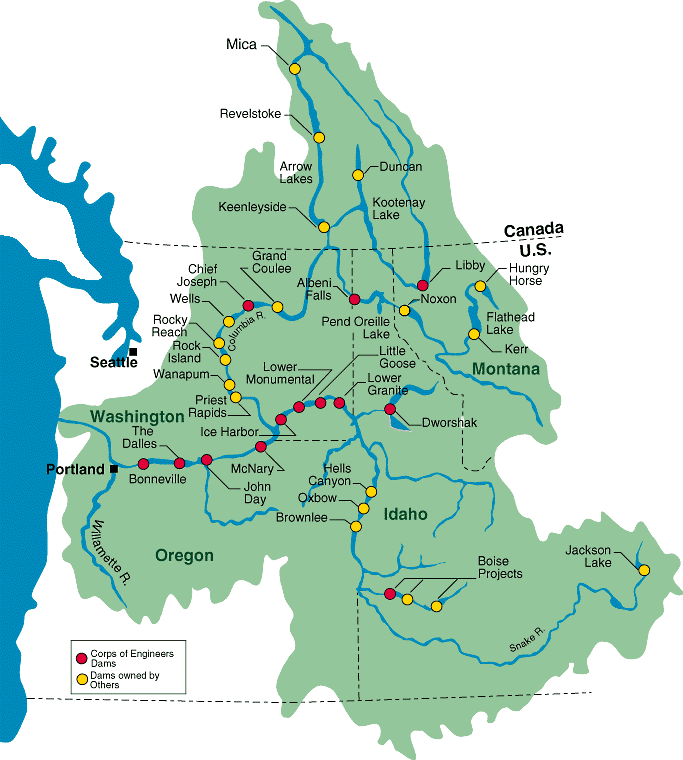Institutional Recommendation 13
Columbia River Treaty
Modernize the Columbia River Treaty to include ecosystem-based functions as a management obligation; an updated coordinated flood risk management plan; provisions that allow for adaptive management, particularly to implement goals and objectives for ecosystem-based functions and address the effects of climate change; restoration of fish passage throughout the basin, specifically at Chief Joseph and Grand Coulee dams and the Hells Canyon Complex; and the enlargement of the U.S. Entity the membership to include tribal representatives.
Issue
Canada and the United States signed the Columbia River Treaty in 1961 to develop and manage the international river system. The treaty came into force in September 1964. The treaty has no set end date, though either party can terminate the agreement beginning in September 2024 with at least a 10-year notice.
Under the treaty, the United States and Canada manage the river for optimized hydropower generation and coordinated flood risk management. Bilateral management of fish and other natural and cultural resources were not considered relevant or necessary under the treaty by either country. Columbia Basin tribes and First Nations were not consulted regarding the impact to their lands, resources and cultures. Canada agreed to build three storage dams and coordinate the operation of these new storage facilities with the U.S. hydroelectric power supply system to optimize hydroelectric power production and to provide coordinated flood risk management. In exchange, Canada receives 50% of the additional power, or downstream benefits, generated in the United States as a result of the new Canadian storage. This is referred to as the Canadian Entitlement.
Canada sold the first 30 years of their share of the downstream benefits, or entitlement, to a U.S. consortium for almost $254 million. The United States now delivers an average of about 483 megawatts of power annually to Canada (estimated annualized capital cost of replacing this power with new generation plants is approximately $300 million). In addition, the United States paid Canada almost $65 million for the benefits of a coordinated flood-control operating plan. This payment represented 50% of the estimated value of the flood loses averted in the United States through September 2024 as a result of this new storage. The United States was allowed to build Libby Dam in Montana, with each country keeping the downstream flood and power benefits realized within its boundaries.
After 2024 the United States loses the assured flood storage provided by Canada. Though the United States can still “call upon” Canada to provide flood storage when it is needed to prevent flooding in the United States, the United States must first put all of its system flood control reservoirs to full “effective use” for flood risk management purposes. The potential effect of this substantial change in flood risk management, coupled with poor forecasting capabilities for basin snowpack, is to drain U.S. reservoirs in anticipation of high run-offs. If these anticipated high run-offs do not materialize as the season progresses, the potential exists for the entire spring freshet to be captured to refill reservoirs for power production and to restore some ecosystem-based functions. The result would be substantially reduced river flows for outmigrating juvenile salmon.
In developing this coordinated river system operations approach under the treaty with Canada, the United States did not consult with the tribes nor consider the effect of this treaty on the tribes’ treaties with the United States nor the effect on the tribes’ cultural and natural resources. The tribes were also excluded from the governance and implementation of the U.S.-Canada Columbia River Treaty.
Actions Needed
- Modernize the treaty to include ecosystem-based functions as a management obligation under the treaty equal to hydropower production and coordinated flood risk management.
- Develop an updated coordinated flood risk management plan with Canada that is built upon some level of assured flood storage in Canadian reservoirs, consistent with meeting goals and objectives for ecosystem-based functions.
- Identify and integrate goals and objectives for ecosystem-based functions into river and reservoir operation plans developed pursuant to the treaty.
- Include provisions in the modernized treaty that allow for adaptive management, particularly to implement goals and objectives for ecosystem-based functions, and to address changes in snowpack and precipitation distribution brought on by climate change.
- Restore fish passage throughout the basin, specifically at Chief Joseph and Grand Coulee dams and the Hells Canyon Complex.
- Enlarge the membership of the U.S. Entity to include tribal representatives.
Desired Outcome
The U.S. government and the tribes work together in the Columbia River Treaty 2014/2024 Review. Using the tribes’ expertise, cultural and natural resource restoration and protection is integrated into coordinated river and reservoir operations and management plans. Ecological processes are also promoted through the treaty in such a way that the tribes receive equitable benefits relative to other interested parties. Each tribe has a voice in the treaty’s governance and implementation.







